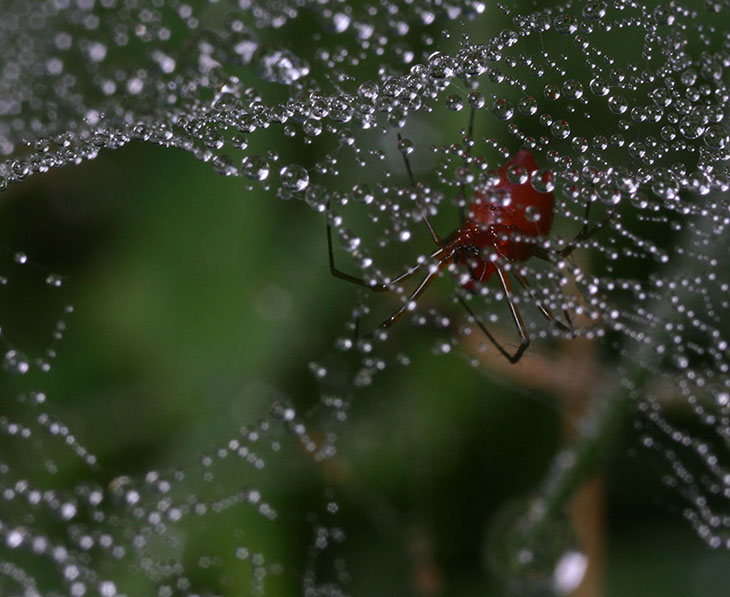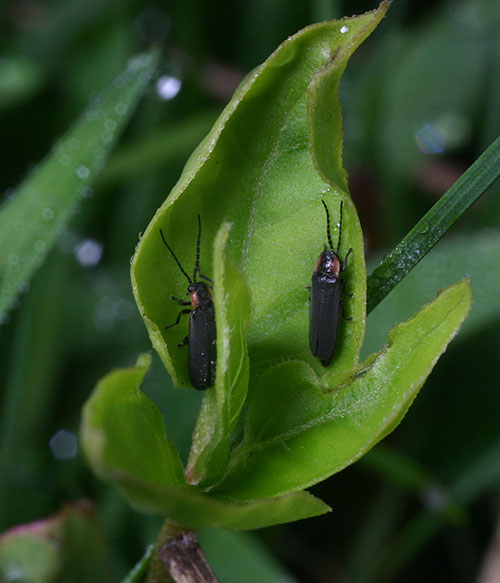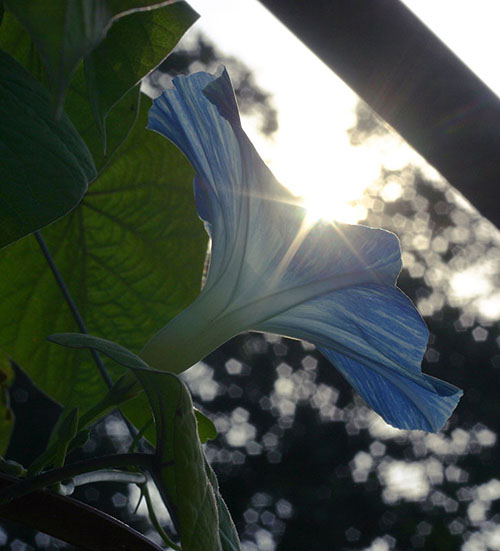
No, the title does not mean last night was burrito night – it just means that, since I don’t do the artsy thing, this must be something else.
In the past several days, my right arm has been bothering me due largely to wielding the camera and flash bracket one-handed, often in awkward positions, but also from several demanding chores. I’ve been trying to let it heal, but that means taking no photos, which can only go for so long, and this morning I fell off the wagon.

 Obviously it was a good morning for dew shots, but there’s something else I want to draw attention to. When I’m not simply trying to illustrate something, I pay a lot of attention to the framing of the image, and stress this to my students. Whether anyone likes the way I’ve tackled it here or not, I tried to present specific subjects, their surroundings, and a general compositional form in these photos. The spider above faces across the frame, but also generates a sense of hiding (which it was – this is typical of many species.) The image at left was composed to keep all of the key leaves in the frame, with the flash adjusted to provide good light without distracting shadows, while still giving good shape to the leaves. Even the cricket at top, one of many determined not to let me get too close, was captured in accord with the grasses and with enough room for the antennae not to be cut off. These may be minor, but imagine how each would look without these efforts. It’s just my way of illustrating that there are more details to be paying attention to than simply your subject.
Obviously it was a good morning for dew shots, but there’s something else I want to draw attention to. When I’m not simply trying to illustrate something, I pay a lot of attention to the framing of the image, and stress this to my students. Whether anyone likes the way I’ve tackled it here or not, I tried to present specific subjects, their surroundings, and a general compositional form in these photos. The spider above faces across the frame, but also generates a sense of hiding (which it was – this is typical of many species.) The image at left was composed to keep all of the key leaves in the frame, with the flash adjusted to provide good light without distracting shadows, while still giving good shape to the leaves. Even the cricket at top, one of many determined not to let me get too close, was captured in accord with the grasses and with enough room for the antennae not to be cut off. These may be minor, but imagine how each would look without these efforts. It’s just my way of illustrating that there are more details to be paying attention to than simply your subject.

While the lighting is a key part of this image, notice that the orb web only shows against the dark background plants, and none of the plants cross behind the spider, emphasizing its position in ‘midair’ – they also provide a sense of scale. The sky itself is grey, but the bright light through the spider and on the plants to the left is yellow and at a low angle, telling us that it’s morning. I’ve actually asked groups of people what time of day images similar to this were taken, which they usually get right, and then ask how they know. Often, they have difficulty specifying it; they noticed the clues subconsciously but cannot define them. However, bridging this gap and being aware of such influences means you can use them better.

High magnification, natural light, and handholding the camera; these three things do not go well together, and in order not to get motion blur, I was using a larger aperture to keep the shutter speed up (it’s all about getting enough light into the camera.) So my depth-of-field was short, and required selecting a perspective that gave me the buds and leaf edge, as well as the contours highlighted by the light angle. I moved around the plant (I’ve been told by the people who gave it to us that it’s some form of basil) until I found what I wanted, and once again aimed for crossing the frame. A lucky benefit is the edges of the big leaf curling down away from the light, outlining them in black against the background and giving a distinctive focal point. The mix of colors in the background give it variety, but if they were in tighter focus it would have been complicated and distracting.
 No one needs to be told that positioning was a key factor in this image. Many weeks ago, we planted a large number of morning glories, mostly to generate natural settings for hummingbird pics (feeder shots are clearly less appealing,) but also to provide more color and, seriously, less to mow. I’ve run into people that consider them weeds, and I’m not sure why – I usually ask what the difference is between a plant and a weed and no one ever answers very well. This planting has been slow and difficult, not in the least helped by deer coming into the yard every couple of weeks and cropping off most of the leaves (doing the same to my almond tree, which tests my we-are-all-one-with-nature tendencies.) But recently we’ve starting getting some blooms, and a nice variety, and so I can introduce to the blog a few more images that are not bugs.
No one needs to be told that positioning was a key factor in this image. Many weeks ago, we planted a large number of morning glories, mostly to generate natural settings for hummingbird pics (feeder shots are clearly less appealing,) but also to provide more color and, seriously, less to mow. I’ve run into people that consider them weeds, and I’m not sure why – I usually ask what the difference is between a plant and a weed and no one ever answers very well. This planting has been slow and difficult, not in the least helped by deer coming into the yard every couple of weeks and cropping off most of the leaves (doing the same to my almond tree, which tests my we-are-all-one-with-nature tendencies.) But recently we’ve starting getting some blooms, and a nice variety, and so I can introduce to the blog a few more images that are not bugs.
This was the wrong lens to use for this kind of shot – the Mamiya 80mm macro does not handle glare well – and it would have been better had I been able to get the arm supporting the hanging basket out of the frame. But at least the electrical wires are missing. You can’t have full-on sunlight coming into the lens to get a useful effect – it has to be just peeking around the edge, so again, position is crucial.
 You might think I simply can’t put down the macro lens (which is true enough,) but a stronger factor in this image is that the plant was a short vine at the edge of the ditch that I don’t want to mow anymore, and so its surroundings weren’t terribly photogenic – no lush foliage or distant trees. While only a botanist might tell it’s a morning glory bloom, the perspective is different and, to me at least, appealing. This one was cropped into a vertical orientation, from the original horizontal, because I felt the elements worked better that way and the pollen becomes more prominent in the frame, contrasting wonderfully against the color. The lone pollen grain off the right was
You might think I simply can’t put down the macro lens (which is true enough,) but a stronger factor in this image is that the plant was a short vine at the edge of the ditch that I don’t want to mow anymore, and so its surroundings weren’t terribly photogenic – no lush foliage or distant trees. While only a botanist might tell it’s a morning glory bloom, the perspective is different and, to me at least, appealing. This one was cropped into a vertical orientation, from the original horizontal, because I felt the elements worked better that way and the pollen becomes more prominent in the frame, contrasting wonderfully against the color. The lone pollen grain off the right was not my point of focus, it was just a happy accident [dammit, I said I should stop doing that] meticulously planned, because a true nature photographer has it all under control.
But the last one is the one I like the best, for its textures and abstractedness. Again, think about how many different ways this could have been approached – what you’d see from a greater distance, or facing directly into the bloom, or even just focusing more tightly on the dewdrop.

It’s been said that a great photographer can get a compelling image out of any subject, and if that’s true, then I’m not a great photographer (except perhaps where it means “big.”) But at the very least, make the effort to examine as many possibilities as you can, to see what kind of images can be found. Hopefully, I’ve at least provided a few ideas.




















































